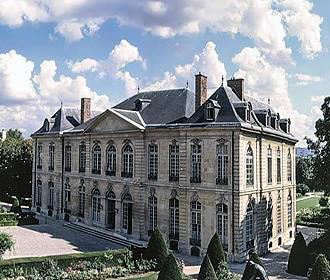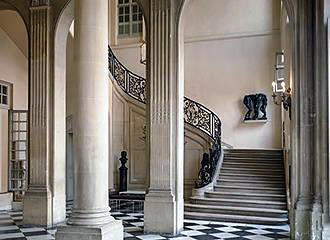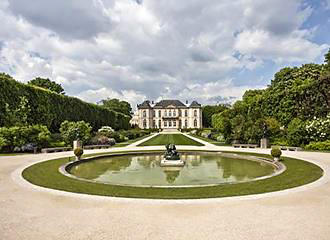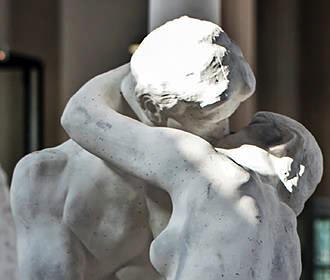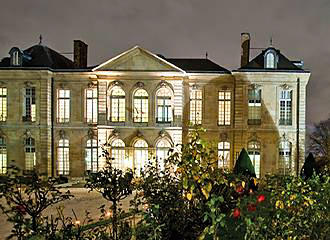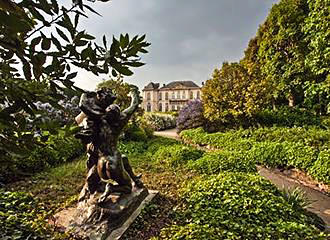Paris Hotel Biron Mansion House and Musee Rodin
The Paris Hotel Biron is a mansion house that was built in the early part of the 1700s, on what was at the time the outskirts of Paris, and this building has a very rich history, yet is now home to the Musee Rodin Museum.
The beginnings of the Hotel Biron Mansion House
The wealthy financier, Abraham Peyrenc de Moras wanted a property built on the outskirts of the city that could combine a town house style with a country residence, and originally called the Hotel Peyrenc de Moras, its construction started in 1727 on Rue de Varenne.
Jean Aubert, who was the chief architect to King Louis XV, who was also the architect for the stables of the Chateau Chantilly, was eventually overseeing the building project and the building became a great example of Rocaille architecture, which was a very fashionable style of architecture at the time.
Unfortunately, Abraham Peyrenc de Moras died in 1732 before the interior of the first floor had been finished, and the Hotel Peyrenc de Moras was left to his wife, then a few years later she rented the mansion house to the Duchess of Maine.
Even though the Duchess of Maine did not do much to the exterior, she made a lot of alterations internally and remained within the Hotel Peyrenc de Moras until she died in 1753.
So instead of renting out the property again, the widow of Abraham Peyrenc de Moras decided to sell the estate and it was purchased by Louis-Antoine de Gontaut-Biron, who became the future Marshal Biron, and this is when the name of the mansion house changed to Hotel Biron.
The next stages in the history of the Hotel Biron
Marshal Biron made many improvements to the grounds of the Hotel Biron, which became known as one of the most beautiful gardens in Paris, and although he still respected the typical French classical garden style with a kitchen garden that was originally laid out by Abraham Peyrenc de Moras, he added many other features.
The ornamental garden was doubled in size, he had a circular pool dug out and part of the grounds were also made into an English garden, and how the grounds of the estate were laid out by Marshal Biron were documented with descriptions and engravings that were published between 1776 and 1778.
Unfortunately, Marshal Biron did not get to enjoy the grounds for very long as he died in 1788 and the Hotel Biron then became occupied by many different owners and tenants. One particular gentleman, by the name of Duke Charost, who owned the estate, transformed the kitchen garden into an English garden and added a stretch of water, and he used to rent out the entire grounds for events such as concerts, dances, firework displays, etc.
In 1810 the Emperor of Russia transferred his embassy to the Hotel Biron, but by 1820 the Duchess of Charost sold the entire estate complete with its outbuildings to three nuns.
One of these called Reverend Mother Madeleine-Louise-Sophie Barat, was actually the founder of the Society of the Sacred Heart of Jesus, and the religious congregation soon moved in, making many changes to the property in order to transform the mansion house into a boarding school for girls.
Over the years, unfortunately much of the original decoration like the wrought ironwork and wood panelling was removed and sold to fund conversion work, the grounds were transformed into an orchard, kitchen garden and pastureland, plus the pool was filled in so that a mound housing an ex-voto dedicated to the Virgin could be erected.
So throughout the 1800s several buildings were constructed for teaching purposes and worship such as a chapel designed by the architect Jean Juste Gustave Lisch, however, the Society of the Sacred Heart of Jesus was dissolved in the July of 1904, and the sisters were evicted, with the Hotel Biron estate being put into the hands of receivers.
From convent and boarding school to the Musee Rodin
Even though it was put up for sale, tenants were allowed to occupy the Hotel Biron from the year 1905 and included famous names such as the painter Henri Matisse, the writer Jean Cocteau and the sculptress Clara Westhoff.
In fact, it was Clara Westhoff who first told the sculptor Auguste Rodin of the opportunity in which to rent a part of the Hotel Biron. And so, in 1908 he rented four south facing ground floor rooms that opened onto a terrace, which he used as his studios, and although the garden had grown quite wild, it must have made a strong impression on Auguste Rodin, as he positioned many of his works amidst the garden greenery.
The Hotel Biron was officially sold to the French government in 1911 and all of the occupants except for Auguste Rodin were asked to leave, and it was from this time that the he occupied the entire building.
However, the French government decided that they were going to sell the estate, yet Auguste Rodin wanted to save the mansion house from destruction and starts negotiations with the French state.
At the time he was already very ill, and in 1916 he had started a bronze bust of Etienne Clemental, but unfortunately this was his final work that never got completed due to him having a stroke.
But it was in this same year that Auguste Rodin offered to donate all of his works to the French state on the condition that the Hotel Biron would become a museum named in his honour, and that he could also see out his remaining time at the mansion house.
At the start of 1917 he married his long suffering partner Rose only weeks before she died, and then Auguste Rodin died in the November of the same year, and it was left down to the executor of his will, Leonce Benedite, to organise the future Musee Rodin, and this Paris museum was officially opened in 1919.
Things have of course changed over the years and renovations were undertaken in the 1960s, which was when the chapel had a glass roof, but in 2003 a major renovation project was announced, which was headed by the architect Pierre-Louis Faloci.
Areas of the museum were modernized and the exhibition spaces were reorganised, plus there was increased office space for staff, as well as providing storage areas, restoration workshops, archive consultation and conservation rooms and an auditorium.
The inauguration of the fully rehabilitated chapel took place once more in the November of 2005, yet more renovations were required.
However, a major renovation project was undertaken at the Musee Rodin, which took over three years to complete, with the museum reopening its doors in the November of 2015 on the birthday of the sculptor, Auguste Rodin, which has become a major Paris tourist attraction once more.
